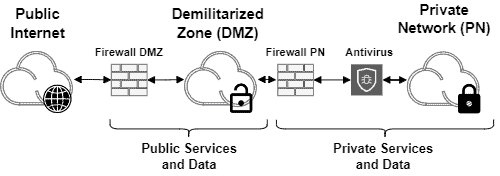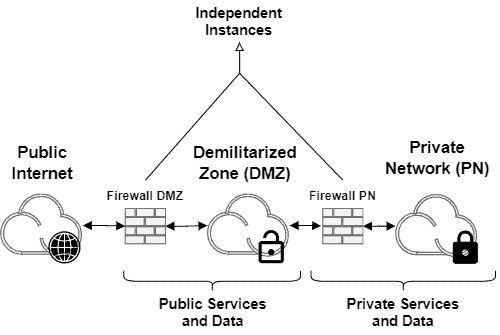1. 简介
在现实生活中,我们对不同的财产会设置不同级别的保护。比如,一个办公室里有个保险柜。我们可能把一些不太重要的文件放在办公桌上,离开时把门锁上。
这些文档受到物理屏障(门)的保护。但通常,出于各种原因,很多人可能都持有你办公室的钥匙。 所以,这些人依然可以访问你放在桌上的文件。
在这种情况下,机密文件就需要额外的安全层。这个新层级旨在限制某些文档只能被特定人群访问。于是,我们可以使用保险柜来保存这些文件,并只向授权人员透露保险柜的密码。
这个场景其实是一个很直观的“非军事区(DMZ)”类比。简而言之,DMZ 是一种外围网络,它将组织的公网与内网分隔开来。
本教程中,我们将深入探讨 DMZ 的特性与实现架构。首先了解 DMZ 是什么及其工作原理,接着分析常见的实现方式,最后讨论部署 DMZ 的优势。
2. 什么是 DMZ(Demilitarized Zone)
DMZ,有时也被称为“外围网络”或“隔离子网”,其核心作用是将公网与组织的内网进行隔离。
DMZ 的主要目的是让组织安全地访问不可信网络(如互联网)。它通过隔离内网与外网,防止未经授权的访问进入内部网络。
实现 DMZ 的关键组件之一是 防火墙(firewall)。
通常来说,我们使用防火墙来隔离公网与 DMZ,以及 DMZ 与内网。这些防火墙的规则通常根据所保护的网络段不同而有所差异。
虽然防火墙是 DMZ 的核心组件,但我们还可以结合其他安全机制来增强整体安全性。例如:
- 入侵检测与防御系统(IDS / IPS)
- 防病毒系统(Antivirus)
- 负载均衡器(Load Balancer)
在分析 DMZ 时,可以从两个关键属性入手:
- ✅ 安全域(Security Domains):将网络划分为多个隔离的区域,每个区域的访问权限受控并可追踪。
- ✅ 纵深防御(Defense in Depth):为保护某个网络域部署多层安全机制,即使某一层失效,其他层仍可抵御攻击。
从信任等级来看,我们可以将网络划分为:
| 网络区域 | 信任等级 |
|---|---|
| Internet | 不可信 |
| DMZ | 半可信 |
| 内网 | 可信 |
信任等级越高,对安全机制的要求也越高。
下图展示了上述概念的示意图:

3. DMZ 的常见架构
DMZ 的基本作用是作为公网与内网之间的中介,并通过防火墙控制进出流量。
根据防火墙的部署方式,DMZ 的实现架构主要有两种:
3.1 双防火墙架构(Double-firewalled Architecture)
这是最经典的 DMZ 架构。在这种架构中:
- 一个防火墙部署在公网与 DMZ 之间
- 另一个防火墙部署在 DMZ 与内网之间
- 两个防火墙独立运行
优点:
- ✅ 更高的安全性:两个独立的防火墙,互不影响
- ✅ 故障隔离:一个防火墙失效不会影响另一个
缺点:
- ❌ 成本较高:需要维护两个防火墙
- ❌ 部署复杂度略高
下图展示了一个典型的双防火墙 DMZ 架构:

3.2 单防火墙架构(Single-firewalled Architecture)
这种架构使用一个防火墙,同时控制公网到 DMZ 和 DMZ 到内网的流量。
优点:
- ✅ 成本低、部署简单
- ✅ 维护成本相对较低
缺点:
- ❌ 单点故障:一旦防火墙被攻破,DMZ 和内网都会暴露
- ❌ 性能瓶颈:一个防火墙处理多个区域的流量,容易成为瓶颈
下图展示了一个典型的单防火墙 DMZ 架构:

3.3 如何选择架构?
选择单防火墙还是双防火墙架构,关键在于 成本与风险的权衡:
- 如果预算有限、安全要求不是特别高,可以选择单防火墙架构
- 如果对安全性要求极高,且有运维能力,建议使用双防火墙架构
⚠️ 注意:一个配置良好的单防火墙,可能比两个配置混乱的双防火墙更安全。
4. DMZ 的优势
部署 DMZ 的核心优势在于为公网与内网之间增加了一层安全隔离。除此之外,还有以下几点优势:
4.1 网络访问控制(Network Access Control)
- ✅ 可以限制并追踪对公网和内网的访问
- ✅ 有助于明确责任归属(例如,追踪攻击来源)
4.2 避免网络扫描(Network Scanning Avoidance)
- ✅ 攻击者通常会扫描网络寻找漏洞
- ✅ DMZ 只暴露必要的服务,隐藏内网结构,降低被扫描和攻击的风险
4.3 提升性能(Performance Improvements)
- ✅ 将面向公众的服务(如 Web、邮件)放在 DMZ 中
- ✅ 避免公网流量影响内网性能,提升整体系统效率
5. 总结
本文我们深入探讨了 DMZ 的技术原理、常见架构及其优势。
✅ DMZ 是一种有效的网络隔离机制,通过划分不同信任等级的区域,提升整体安全性。
✅ 常见架构包括双防火墙和单防火墙,各自适用于不同的安全需求和预算场景。
✅ 部署 DMZ 不仅能增强安全性,还能提升网络管理的灵活性与性能。
最终,DMZ 的价值在于它提供了一种“纵深防御”的策略,使组织能够更好地应对来自外部的威胁。
示例建议:如果你正在设计一个企业级网络架构,建议根据业务需求和安全等级选择合适的 DMZ 架构,并结合 IDS/IPS、负载均衡等机制,打造一个多层次的防护体系。